|
This is a
warning: DXing is addictive, and going on DXpeditions
even more so. One week a year in Lapland wasn't
enough, so I and Håkan Sundman headed for
a second week of intense DXing in the Arctic. Solar
activity rose to surprisingly high levels, but fortunately
it didn't seem to affect propagation conditions
too much. We were able to listen to North American
stations through the entire week, and are quite
happy with the results, although we didn't get any
really sensational rarities.
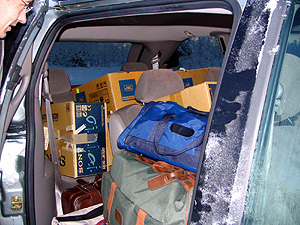
Let's see - what more
can we fit in? (Photo by Håkan Sundman) |
Though both of us
are regular visitors to Lemmenjoki,
this was the first time in nearly a decade that
we happened to be there at the same time (see LEM85
report on our previous DXpedition together).
Sharing a ride was easy, as we both live 11-13 kilometers
east of downtown Helsinki. On Friday afternoon I
packed my stuff in my wife's Chrysler Voyager, which
I thought would be big enough for our record amount
of equipment, and headed over to Håkan's home
to fill whatever empty space the minivan still had.
We had voted for comfort, and instead of driving,
would take our vehicle north by train. As we arrived
at the Helsinki railway station, I was in for a
surprise. I was told that the Voyager tends to accumulate
snow in the engine compartment. It should be loaded
the rear end facing the wind, so it had to be backed
up all the way over the railroad cars until the
last car, where we parked. With perhaps a foot of
leeway on both sides I was lucky not to scratch
the vehicle.
Changing Seasons
We still had time
for dinner at an Indian restaurant near the railway
station before the whistle blew at 6.56 p.m. A feeling
of relief and anxious anticipation filled our minds
as we began our journey from the grim, rainy and
unseasonally warm capital to Lapland, where winters
are still what they are supposed to be; below-freezing
temperatures and snow - a lot of it, as we were
to discover.
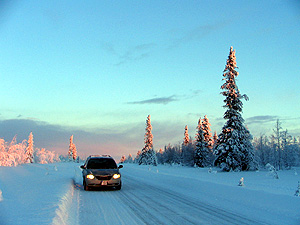
Lemmenjoki here we come |
We
arrived in Kolari almost in time, and manouvered
the Voyager out intact. As customary, we first drove
up to Kittilä to eat and to stock for groceries
and gas before heading out to the wilderness. Outgoing
DXpeditionists Jari Ruohomäki (JPR) and Jim
Solatie (JMS) had quite good conditions nearly
all the time. We ran into Jim on the road in the
middle of nowhere as he had a train to catch, while
Jari was still in Lemmenjoki when we arrived there.
It took about an hour to unload all the stuff, arrange
the equipment and start listening. Our equipment
included an array of JRC's communications receivers
(models NRD-525, 535 and 545), recorders (mostly
Sony minidisc) and the usual beverage antennas,
each about 1 kilometer in length.
I Wish They All
Could be California
Conditions
to the U.S. West Coast were quite good. Within a
minute the first new station was identified, KCTC
Sacramento CA on 1320 kHz at 1334 UTC. Later that
afternoon Håkan even identified KXRO Aberdeen
WA there. 1320 kHz is an exceptionally tough frequency
because of a superpower Norwegian on 1314 kHz and
the 1320 kHz dominant, CHMB Vancouver BC. West Coast
stations were heard until around 1510 UTC, which
was unusually late.
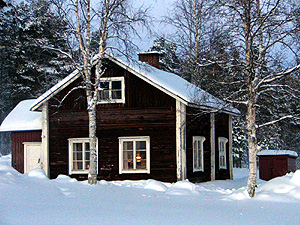
Our home away from home (Photo by Håkan
Sundman) |
Saturday
afternoon proved to be indicative of the conditions
to come. We were able to enjoy North American stations
every day of the week with varying conditions. A
normal pattern was that American signals would surface
around midnight UTC, perhaps making a brief and
weak appearance even around 2200-2300, but never
early enough for daytimers to be heard. We had a
constant watch though. Nighttime conditions would
be general in nature, with stations from Newfoundland
to New England, Ontario and the Great Lakes, sometimes
as far as Missouri and Kansas. This would continue
for a couple of hours until the signals started
to fade out, allowing us to sleep for a couple of
hours before waking up before dawn for the best
DX session of the day.
From Sea to Shining
Sea
Prime
time for DXing was from 0600 UTC to around 0900
UTC, when North American and Mexican stations would
be heard best. Usually conditions in the very beginning
favored the East Coast or the Great Lakes, after
which there was a rapid shift to the West Coast,
and whatever conditions there would be at any other
time of the rest of the day, only stations from
the Rockies or the West Coast would be heard. Unfortunately
there were quite a lot of Canadian stations in the
mix. Canadians, especially from Alberta, Manitoba
and Saskatchewan, tend to dominate the frequencies
they operate on, making it difficult to dig anything
new underneath. On several days there was somewhat
of a peak of West Coast stations in the early afternoon,
but never as late as immediately after our arrival.
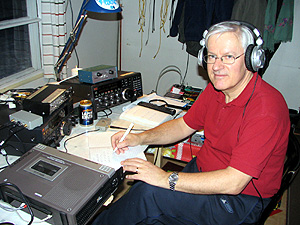
Håkan Sundman (HS) |
Apart
from an overdose of Canadians, another handicap
was that there was never really a clear focus, but
conditions favored very large areas, sometimes even
coast to coast, which resulted in the usual suspects
dominating the dial. Mexican stations are always
a real pleasure to listen to, and a pretty good
opening to Mexico was noted on Tuesday, January
11, at 0645-0845 UTC. The best catches were XEDRD
Durango DG (820 kHz) and XEGYS Guaymas SO (1040
kHz).
Especially in retrospect, the best afternoon for
U.S. West Coast proved to be Tuesday, January 11,
when we caught KPAM Troutdale OR (860 kHz), KZNY
Milwaukie OR (1010 kHz), KMAS Shelton WA (1030 kHz)
and KWDB Oak Harbor WA (1110 kHz), all within 30
minutes! One more neat catch from the U.S. was KBIV
El Paso TX (1650 kHz) on January 10, previously
unheard in Finland. Just before our departure it
seemed that conditions to North America were falling
rapidly, and hardly anything was heard on the morning
of Saturday, January 15.
15 Minutes of Fame
Further
south, stations from the Caribbean were not heard,
which was a bit disappointing. Likewise, conditions
to South America were well below average all the
time. Colombia and Venezuela were absent, and only
a few Brazilian and Argentinian stations were heard.
We noticed really only one good peak in the conditions
which lasted for about 15-20 minutes. This 15 minutes
of Lapland fame took place on Wednesday, December
12, at 0230 UTC. It was part of a very interesting
and rapid movement in conditions. First there were
the regular U.S. Great Lakes stations, which vanished
around 0215 UTC. For a moment nothing, then Southern
South America (including Radio Murialdo on 1290
kHz and Radio Nacional, Rosario, on 1300.23 kHz)
came strong for a while until they also disappeared,
giving way to U.S. West Coast stations at 0250 UTC,
and finally Alberta stations strong at 0315 UTC.
It was quite a challenge to try to keep up with
the conditions, constantly switching antennas and
browsing the dial.

Arctic beauty (Photo by Håkan Sundman) |
An
interesting window of opportunity took place on
1440 kHz, when Luxembourg had a break at 0000-0030
UTC, allowing trans-Atlantic signals through. However,
this lasted only for a few days, and we didn't catch
anything spectacular. In the wee hours of the morning
Luxembourg uses DRM, effectively blocking the channel
for any other stations.
Conditions
to Asia were no match to North America, but afternoons
around 1300-1600 UTC were mostly spent on chasing
mediumwave signals from the East. Japanese stations
were heard only very seldom, Chinese much more often,
and South Asian countries quite regularly. However,
again the problem was that conditions covered such
a wide area that the regular powerhouses normally
dominated the dial, and it was pretty easy to predict
what could be heard.
Perhaps
the most interesting observation from Asia was how
well some Chinese stations from the Western provinces
were heard around sunrise in China. Although I have
heard them many times before, they have never before
been as strong as on Thursday, January 13, when
Chinese was heard on a couple of frequencies even
after 0200 UTC, which is after sunrise in Western
China. The best catches from Western China were
Urumqi News Channel, Urumqi XJ (792 kHz) and Xining
PBS, Xining QH (1476 kHz), both probably previously
unheard in Europe.

Mika Mäkeläinen (Photo by Håkan
Sundman) |
Australia
and Oceania offered a few really nice surprises.
We had a beverage antenna pointing at 30 degrees,
optimized for the coveted island nations of the
Pacific. We managed to hear Marshall Islands (1098
kHz) and Tonga (1017 kHz) around midday on Monday,
January 10. Another antenna pointing at 55 degrees
gave us a few Australian X-band stations right after
our arrival on Saturday, and again on Tuesday, January
11. These were heard well after dark.
With relatively good conditions elsewhere, we didn't
have much time for Europe, Africa or the Middle
East. Spanish stations were hunted during local
breaks, but nothing spectacular was netted. The
best morning was Thursday, January 13, when conditions
surprisingly favored the Eastern part of Spain for
a moment.
Greenland on Shortwave
There
are only relatively few active shortwave stations
that we still haven't identified, so shortwave was
not a major target, and neither was it very practical,
as much of the time the tropical bands were completely
dead. However, one very interesting station was
heard; Kalaallit Nunaata Radioa (KNR) from Tasiilaq,
Greenland, was picked up on 3815 kHz USB. This was
presumably the first time that the station had been
heard outside Greenland.
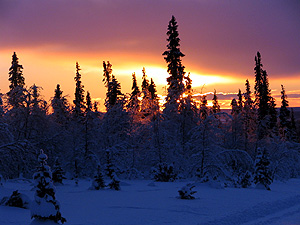
Sunset in Lapland (Photo by Håkan Sundman) |
As DXing was pretty
successful, we minimized the time spent on everything
else. The regular DXpedition routine developed quickly.
We normally slept for a few hours in the evening
around 1700-2100 UTC, and a little more in the early
morning around 0300-0530 UTC, taking turns in keeping
an eye on the conditions. The better the conditions
were, the worse sleep deprivation we developed...
cooking was basic, mostly preparing sandwiches in
a hurry and heating meals in a microwave oven.
Weatherwise
it was mild for January, ranging from -30 to -10
Celsius (-22 to 14 F), exactly the same as a month
earlier. We did get a lot of snow though, originating
from the fringes of the fierce storms that ravaged
further south in Scandinavia during the week. Snow
caused some problems because we needed to take down
a couple of antennas as part of preparations to
end the DX season. Jim and Jari had asked the locals
to use snow mobiles to make paths along the antennas
in the knee-deep snow, but because of the storms,
not much was left.
But for us, space weather was more important than
temperature readings outside our cabin. The week
was rather bumpy with pretty high levels of the
A-index and the solar flux, but surprisingly it
didn't seem to have much of an adverse effect on
the conditions before a major deterioration on the
day of departure, January 15. This table lists the
most important indices during our DXpedition:
| Date |
Solar
flux |
Sunspot
number |
Planetary
A index |
Min-max
solar wind speed (km/sec) |
Number
of flares (events) |
| STAR |
SEC |
STAR |
SEC |
Daily low - high |
C |
M |
X |
| 8.1.2005 |
88.5 |
17 |
34 |
29.5 |
30 |
7-80 |
445-666 |
1 |
|
|
| 9.1.2005 |
87.5 |
17 |
28 |
4.0 |
4 |
0-12 |
443-536 |
1 |
1 |
|
| 10.1.2005 |
90.1 |
30 |
40 |
5.8 |
6 |
3-9 |
370-545 |
1 |
|
|
| 11.1.2005 |
94.2 |
54 |
25 |
14.0 |
14 |
5-27 |
388-464 |
2 |
|
|
| 12.1.2005 |
102.1 |
57 |
58 |
30.3 |
30 |
15-56 |
417-769 |
|
|
|
| 13.1.2005 |
115.6 |
113 |
77 |
13.0 |
13 |
7-27 |
609-839 |
9 |
|
|
| 14.1.2005 |
129.8 |
103 |
65 |
11.6 |
12 |
4-27 |
532-757 |
28 |
5 |
|
| 15.1.2005 |
144.9 |
110 |
100 |
22.5 |
22 |
6-67 |
527-706 |
17 |
7 |
2 |
(information
collected by Jan Alvestad)
All in all
a successful week, although it will take weeks
and months to uncover exactly what stations we
heard as the amount of recordings grew bigger
than ever before. Therefore our DXpedition
log (with a few sound bites) at the time of
publishing is only preliminary, and you should
recheck it later in the year to get a complete
picture. It can be useful to read also the notes,
which explain some basics.
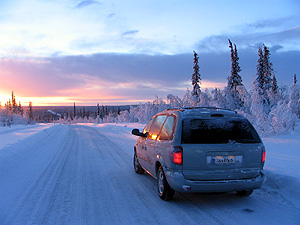
Heading home |
We unplugged
our receivers after 0800 UTC on Saturday, because
nothing much was heard on the dial. The last DXpeditionists
of the season, Martti
Karimies (MKA) and Jari Sinisalo (JSN), arrived
around midday, armed with a respectable collection
of vintage wine and other culinary delights to
keep them busy and happy under potentially lousy
reception conditions.
We drove down in beautiful crispy weather, and
saw the first rays of the sun in a week as we
approached Kittilä. After a restaurant pit
stop we made it in time for the train, departing
from Kolari at 6.50 p.m. local time, and arriving
in Helsinki on time, at 7.48 a.m. on Sunday morning.
This time the Voyager engine compartment was loaded
with snow, although reverse driving had been practised
once again. After the engine had been heated and
the driver cooled down over breakfast, we were
able to head home in the capital, which was just
as dark, rainy and murky as one week earlier.
Ideal conditions for staying inside and continuing
the DXpedition by reviewing our neverending minidisc
recordings...
Published
on January 20, 2005, slight editing later
  
|